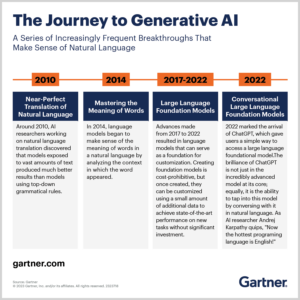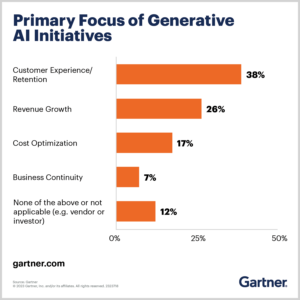Navigating the Generative AI Landscape
In the fast-changing world of artificial intelligence, there’s a hot topic—Generative AI. It’s not just for businesses; it’s a big deal for society, marking a new era where people and machines work together to influence how we interact every day. In this blog post, we’ll explore important information from Gartner experts as they address the big questions about Generative AI for businesses.
Understanding Generative AI
At its core, Generative AI is a transformative force that leverages existing data to craft new, realistic artifacts on a massive scale. These creations span a spectrum of media, from images and videos to music, text, and even software code. Powered by AI foundation models, these algorithms undergo extensive training on diverse, unlabeled data, requiring complex mathematical computations and significant computing power.
Today, Generative AI responds to natural language requests, eliminating the need for coding expertise. Its applications, however, extend far beyond, with notable innovations in drug and chip design and material science development.
The Journey to Generative AI
The recent surge in Generative AI’s popularity can be traced through Gartner’s Hype Cycle™ for Artificial Intelligence. While it has transitioned from the Innovation Trigger to the Peak of Inflated Expectations, the real breakthrough came in late 2022 with the launch of ChatGPT by OpenAI. This chatbot, capable of remarkably human-like interactions, sparked widespread attention and marked Generative AI’s entry into mainstream consciousness.
Gartner envisions Generative AI evolving into a general-purpose technology, akin to the transformative impacts of the steam engine, electricity, and the internet. As the initial hype subsides, its real-world implementations will reveal its true potential across various industries.

Benefits and Applications
The benefits of Generative AI are diverse, ranging from accelerated product development and enhanced customer experiences to improved employee productivity. However, the specifics depend on the use case. Gartner emphasizes the importance of aligning use cases with key performance indicators (KPIs) to ensure operational efficiency improvement or the creation of new revenue streams.
According to a Gartner webinar poll, executives primarily invest in Generative AI for customer experience and retention (38%), followed by revenue growth (26%), cost optimization (17%), and business continuity (7%).

Risks and Recommendations
Despite its promise, Generative AI presents significant risks, rapidly evolving as threat actors leverage the technology for “deep fakes” and scams. Gartner highlights several oversight risks, including lack of transparency, accuracy issues, bias, intellectual property concerns, and cybersecurity threats. Enterprises are urged to exercise caution and implement controls to mitigate these risks.
Gartner recommends addressing key questions such as defining responsible use, ensuring compliance, and determining consequences for irresponsible use. Additionally, considerations about consent, trust, content creators’ rights, and ongoing regulatory monitoring are essential.
In conclusion, Generative AI holds immense promise but demands careful navigation. By understanding its potential, risks, and recommended best practices, enterprises can harness its power to drive innovation responsibly and ethically in this AI-driven era.
The Impact of Generative AI on Revenue, Productivity, and Risk Management
In the ever-evolving landscape of technology, generative AI emerges as a game-changer, promising to revolutionize how businesses operate and innovate. This transformative technology not only presents new possibilities but also addresses key challenges, making it a crucial factor for businesses looking to gain a competitive edge. Let’s delve into how generative AI contributes substantial business value across various dimensions.
Revenue Opportunities:
Accelerated Product Development: Generative AI empowers enterprises to expedite product development processes. From groundbreaking pharmaceuticals to eco-friendly household cleaners, this technology facilitates the creation of innovative products, pushing the boundaries of what’s possible.
Diversification of Revenue Channels: According to Gartner, organizations with advanced AI maturity stand to reap greater benefits in terms of revenue. Generative AI opens doors to new revenue channels, allowing businesses to explore untapped markets and capitalize on diverse opportunities.
Cost and Productivity Opportunities:
Worker Augmentation: Generative AI acts as a force multiplier for human capabilities. It enhances workers’ efficiency by assisting in tasks such as drafting and editing text, image manipulation, content summarization, and code generation. This not only boosts productivity but also unleashes creativity by automating routine tasks.
Long-term Talent Optimization: The future workforce will thrive in a symbiotic relationship with AI. Employees will be distinguished by their ability to collaborate seamlessly with AI in conceiving, executing, and refining ideas. This dynamic partnership accelerates skill development, making workers more versatile and proficient.
Process Improvement: Generative AI unlocks hidden value within vast stores of content, transforming previously unexploited data into actionable insights. This paradigm shift in workflow management enhances operational efficiency, streamlining processes and fostering innovation.
Risk Opportunities:
Enhanced Risk Mitigation: Leveraging its analytical prowess, generative AI provides comprehensive visibility into data, enabling advanced pattern recognition. This capability proves invaluable in identifying potential risks, from customer transactions to software vulnerabilities, allowing businesses to proactively mitigate threats.
Sustainability Integration: Generative AI plays a pivotal role in helping enterprises adhere to sustainability regulations. By analyzing data and influencing decision-making processes, it aids in mitigating risks associated with non-compliance and facilitates the seamless integration of sustainability into product design and business operations.
Gartner’s predictions:
By the year 2024, 40% of enterprise applications are expected to incorporate conversational AI, a significant surge from the less than 5% observed in 2020.
In 2025, it is anticipated that 30% of enterprises will have adopted an AI-enhanced approach to development and testing, a notable increase from the 5% recorded in 2021.
The year 2026 is forecasted to witness generative design AI automating approximately 60% of the design process for new websites and mobile applications.
By 2026, a staggering number exceeding 100 million individuals are projected to enlist robocolleagues to actively contribute to their work.
Looking ahead to 2027, it is predicted that nearly 15% of newly developed applications will be autonomously generated by AI, completely bypassing human involvement—an occurrence that is currently nonexistent.
Conclusion:
Generative AI is poised to be a transformative force, offering a myriad of opportunities for businesses to thrive. From revolutionizing product development and optimizing workforce capabilities to enhancing risk management and promoting sustainability, the impact of generative AI on business value is undeniable. As we step into the future, organizations that embrace and harness the power of generative AI are likely to emerge as leaders in their respective industries.
References: Gartner